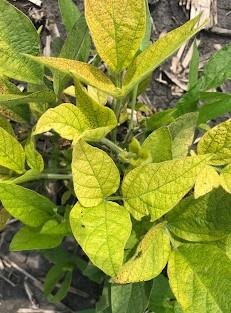By Liz Stahl and Angie Peltier et.al
On the July 6, 2022, Strategic Farming: Field Notes episode, Dan Kaiser, Extension Nutrient Management Specialist, and Seth Naeve, Extension Soybean Specialist, joined moderators and Extension Educators Angie Peltier and Anthony Hanson in discussing iron deficiency chlorosis (IDC) in soybean. Yellow soybeans are showing up in fields throughout western Minnesota this year.
What is iron deficiency chlorosis (IDC)?
 |
Iron deficiency chlorosis symptoms
in soybean. Photo by Angie Peltier |
IDC does not occur due to a deficiency of iron in the soil. IDC is caused by the inability of some plant species to extract iron from the soil in a plant available form. This results in yellowing, or chlorosis, of leaves between the leaf veins while the veins remain dark green. A plant requires iron to make chlorophyll, the green pigment vital to photosynthesis. A large amount of iron is usually in the soil, but it is not in the soluble form required by plants. IDC is particularly a problem in higher pH soils and in soils with large amounts of calcium carbonate.
Conditions that favor IDC
Kaiser and Naeve discussed soil conditions that can affect the availability of iron, such as high soil pH, compaction, high soluble salt concentration and poor soil drainage. Environmental conditions also play a role in the development of IDC.
The amount of bicarbonate in the soil correlates with IDC in soybean - the more bicarbonate in the soil the higher the occurrence of IDC. Bicarbonates are formed in the soil typically when water-logged soils trap carbon dioxide. Bicarbonates aren’t stable, so when the soil is exposed to aeration, bicarbonates break down to carbon dioxide, which can then leave the soil.
There is also a linkage between high soil nitrate content and IDC. IDC issues can be greater where residual nitrates are higher in the soil. Kaiser noted there may be more IDC in some fields this year due to higher levels of residual nitrates after last year’s drought conditions, particularly in the Red River Valley. Naeve also noted the importance of considering soybean root depth. Water, nitrate and the amount of salts in the soil can change throughout the profile, impacting the incidence of IDC as soybean roots grow deeper in the soil profile.
Managing IDC
Planting a tolerant variety is the number one defense against IDC in soybean. Research shows that tolerant varieties have a higher yield potential than less tolerant varieties where IDC is a problem, but an even greater yield potential may occur when combined with other practices that reduce IDC.
Additional practices shown to be effective in managing IDC include using an ortho-ortho EDDHA iron chelate source applied in a band directly on the soybean seed at planting. The greatest economic advantage can occur when those areas of a field with a history of IDC symptoms are targeted with an in-furrow iron-chelate at planting. Foliar applied chelates however, may only green up tissue that comes into contact with the product. New vegetative growth after treatment may still be yellow, as iron is not mobile in the plant. Placement of an ortho-ortho iron chelate with the seed has provided the best return on investment where levels of IDC have been moderate or high.
A companion crop of oats with soybean has also been shown to help reduce IDC. The oats help take excess nitrate and moisture from the soil. In fields where IDC has been a problem, soybeans grown with oats have greened up and yielded better than soybeans without an oats companion crop. It is important, however, to terminate the oats before they reach more than about 10 inches in height, as competition with the soybean crop for water could be an issue when moisture is limiting.
Attempts to acidify the soil may sound good in theory, but in practice, the majority of our soils have a high buffering capacity, which means they have high resistance to a pH change. It would take a large amount of elemental sulfur to result in a very small drop in pH, and pH levels would likely then rise back to where they were within two to three years.
Source : umn.edu